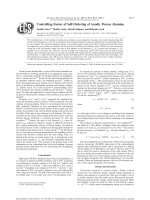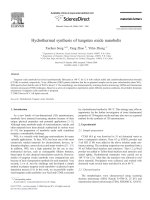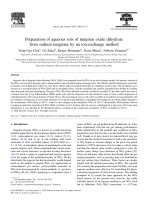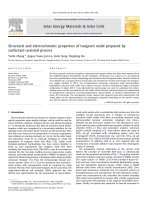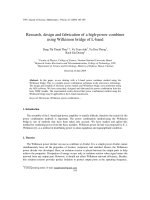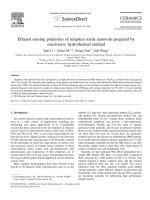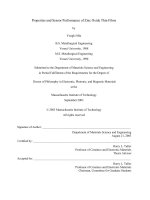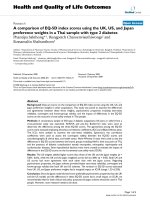Fabrication of tungsten oxide nanostructured films using anodic porous alumina and application in gas sensing
Bạn đang xem bản rút gọn của tài liệu. Xem và tải ngay bản đầy đủ của tài liệu tại đây (3.82 MB, 118 trang )
Fabrication of Tungsten
Oxide Nanostructured
Films Using Anodic
Porous Alumina and
Application in Gas Sensing
Submitted by
See Yeow Hoe, Godwin
Department of Electrical and Computer Engineering
In partial fulfillment of the
Requirements for the Degree of
Master of Engineering
National University of Singapore
ABSTRACT
ABSTRACT
Anodization, a self-ordering technique for creating nano-channels in alumina, is a
simple and cheap method for creating highly ordered nanoporous film. The
dimensions of the nanochannels, including pore diameter and pore depth can be
controlled accurately through appropriate anodization conditions. In this thesis,
we examined the suitability of using porous alumina as a supporting substrate for
creating a textured metal oxide semiconducting (MOX) nanofilm to be used as a
gas sensor in argon ambient.
A measurement system that can be used to
characterize a gas-sensing device with respect to sensitivity, response time and
recovery time was designed and set up. A chemical vapour deposition (CVD)
system for CVD of tungsten was designed and set up as well. The textured film
was deposited using low pressure chemical vapour deposition (LPCVD) of
tungsten. Tungsten hexacarbonyl W(CO)6 was used as the precursor. Electrical
and structural characterization were performed on the deposited films.
Comparison of oxygen sensing characteristics were made between the textured
film deposited on porous alumina and that of a thin film deposited on glass
substrate using the measurement system. It was found that the non-textured film
performed better than the textured film in terms of sensitivity, response time and
recovery time. Possible explanations for the observed phenomena were given.
Lastly, a novel honeycomb nanostructure was fabricated using pyrolysis of
tungsten hexacarbonyl on pore-widened anodic porous alumina. This structure
has potential applications in gas-sensing.
1
LIST OF FIGURES
ACKNOWLEDGMENTS
The author would like to thank the following people, who have helped in one way
or another through the course of this project:
Supervisors A/Prof Chim Wai Kin and A/Prof John Thong for patience, guidance
and invaluable suggestions throughout the course of the project, and for imparting
many life application skills;
Mrs Ho Chiow Mooi and Mr Goh Thiam Pheng for their assistance in obtaining
the resources required for experiments;
Jayson Koh for providing sound advice and technical support, and for making his
stay in CICFAR II a comfortable and enjoyable one;
Chiam Sing Yang for helping with X-ray photon spectroscopic analysis;
Tan Soon Leng, Alfrad Quah, Goh Szu Huat, Ho Heng Wah, Yao Guhua, Yan
Jian, Li Qi, Luo Tao, You Guofeng, Wong Kin Mun for working together in
CICFAR and reducing the stress of working on the project by having meals and
breaks together;
Parents Mr and Mrs See for providing strong moral support and lastly;
Friends from Baptist Fellowship Church who labored with him in prayer on his
project.
2
LIST OF FIGURES
LIST OF FIGURES
Figure 2.1: Simplified Diagram of Anodization ....................................................15
Figure 2.2: Schematic Microstructure of an Anodic Film [Henley 1982] .............16
Figure 2.3: Ideal Hexagonal Pore Array ................................................................17
Figure 2.4: Migration of Al3+ and O2- ions during Anodization [Jessensky 1998]20
Figure 2.5: Empirical Trend of Interpore Distance and Pore Diameter vs
Anodizing Voltage [Sullivan et al. 1970] ......................................................25
Figure 2.6: Wire grid type polarizer made of anodized alumina film. The film
transmits the light polarized vertically to the metal columns, and attenuates
light polarized horizontally to the columns. ..................................................26
Figure 2.7: A typical MISFET gas sensor. It is similar to a MOSFET except that
different gate metals may be used to sense different gases. For example, to
sense hydrogen, a palladium gate may be used [Bergveld et al. 1998]. ........28
Figure 2.8: A typical acoustic wave gas sensor device. It consists of two sets of
interdigital transducers. One transducer converts electric field energy into
mechanical wave energy; the other converts the mechanical energy back into
an electric field. (Extracted from
..........................28
Figure 2.9: Schematic diagram of the Taguchi sensor. 1 and 2 are electrical
contacts. 3 indicates a porous ceramic body and 4 represents a semiconductor
material filling the pores in the ceramic body. ..............................................30
Figure 2.10: Physical model and associated band model of the grains of a MOX
sensing layer [Hoel 2004]. .............................................................................31
Figure 2.12: Schematic illustration of the ZrO2 HEGO sensor. ............................37
Figure 2.13: Typical response of a commercial ZrO2 oxygen sensor to changes in
air-fuel ratio of an engine...............................................................................40
Figure 2.14: Atomic force microscopy image of a metal/S-SWNT/metal sample
used for the experiments conducted by Kong’s group [Kong et al. 2000]. The
diameter of the nanotube is 1.8 nm. The metal electrodes consist of 20-nmthick Ni, with 60-nm-thick Au on top............................................................42
Figure 2.15: Schematic model of crystalline WO3 in the undistorted cubic phase.
........................................................................................................................43
Figure 2.16: Current response of a palladium nanowire-based H2 sensor under
exposure to hydrogen/nitrogen mixtures (concentration of H2 as shown)
[Walter et al. 2002] ........................................................................................47
Figure 2.17: Resistance response of annealed titanium oxide film following a step
change in composition from air to 50ppm NH3 in air [Manno et al. 1997] ..47
Figure 2.18: FTIR spectra of SnO nanopowder film at 300 oC (a) under 50 mbar
oxygen; (b) after addition of 10 mbar CO; (c) after evacuation [Baraton et al.
2002]. .............................................................................................................49
3
LIST OF FIGURES
Fig. 2.19: Variations of the infrared energy transmitted by SnO powder film
versus gas exposures: (a) at 300 oC; (b) at 150 oC [Baraton et al. 2002].......49
Figure 3.1: Schematic diagram of the LPCVD setup used to deposit tungsten via
pyrolysis of tungsten hexacarbonyl ...............................................................54
Figure 3.2: Schematic diagram showing process of fabricating (a) flat substrate
device and (b) textured substrate device........................................................59
Figure 3.3: Schematic representation of the setup used to characterize the gas
sensing characteristics of devices. .................................................................61
Figure 4.1: SEM micrographs of samples obtained by anodizing at (a) 40V, (b)
45V, (c) 50V and (d) 55V in 0.3M oxalic acid..............................................66
Figure 4.2: SEM micrographs of a typical sample of anodized alumina anodized at
50V showing (a) three-dimensional view and (b) bottom view. ...................67
Figure 4.3: Deposition rate of tungsten by pyrolysis of tungsten hexacarbonyl on
flat alumina substrate .....................................................................................68
Figure 4.4: Tungsten film deposited by pyrolysis of tungsten hexacarbonyl
(W(CO)6) on alumina substrate for a duration of (a) 10min, (b) 5min, (c)
2min, (d) 1min and (e) 30s.............................................................................69
Figure 4.5: SEM micrographs showing three-dimensional views of films deposited
by pyrolysis of tungsten hexacarbonyl with durations of (a) 1 min and (b)
30s. .................................................................................................................70
Figure 4.6: AFM images of films deposited by pyrolysis of tungsten hexacarbonyl
with durations of (a) 30 s and (b) 1 min.........................................................71
Figure 4.7: XPS Depth Spectra of tungsten film deposited by pyrolysis of tungsten
hexacarbonyl. The time in the legend indicates the sputtering duration before
each XPS spectrum was acquired. .................................................................72
Figure 4.8: Arrhenius plot (ln R vs 1/T) of deposited film before and after
oxidation. .......................................................................................................73
Figure 4.9: SEM micrographs showing the surfaces of fabricated samples using
(a) front-side deposition and (b) reverse-side deposition. .............................76
Figure 4.10: Typical (a) flat substrate device and (b) textured substrate device that
were used for performing gas sensing experiments.......................................77
Figure 5.1: Response graph of a typical device to nitrogen. The test was
conducted at 473K (200oC). 30% nitrogen was flowed into the chamber at
500s. The nitrogen flow was switched off at 3500s......................................78
Figure 5.2: Graph showing the compensation method for small temperature
fluctuations during gas sensing experiments. The black line is the corrected
current (Ac), after compensating for the small temperature fluctuations, and
the grey line is the actual current taken during the experiment (I). ...............80
Figure 5.3: Ideal response curve in the presence of the test gas and subsequent
removal of the gas..........................................................................................81
4
LIST OF FIGURES
Figure 5.4: Time variation of the current of flat substrate device under a DC bias
of 5V at 473K (200oC) and at a ammonia concentration of (a) 30%, (b) 20%,
(c) 10%, (d) 5% and (e) 2%. The line at the top indicates temperature (oC).
The grey line indicates the actual current and the black line indicates the
compensated current. .....................................................................................84
Figure 5.5 Sensitivity of flat substrate device to various concentrations of
ammonia at test temperatures ranging from 433K to 573K...........................85
Figure 5.6: (a) Response time and (b) recovery time of flat substrate device to
various concentrations of ammonia at test temperatures ranging from 433K to
573K...............................................................................................................86
Figure 5.7: Time variation of the current of textured substrate device under a DC
bias of 5V at 473K and at an ammonia (NH3) concentration of (a) 30%, (b)
20% and (c) 10%............................................................................................87
Figure 5.8: Sensitivity of textured substrate device to various concentrations of
ammonia at test temperatures ranging from 433K to 573K...........................88
Figure 5.9: (a) Response time and (b) recovery time of textured substrate device to
various concentrations of ammonia at test temperatures ranging from 433K to
573K...............................................................................................................88
Figure 5.10: Time variation of the current of flat substrate device under a DC bias
of 5V at 473K and at oxygen (O2) concentration of (a) 30%, (b) 20%, and (c)
10%. ...............................................................................................................90
Figure 5.11: Sensitivity of flat substrate device to various concentrations of
oxygen at test temperatures ranging from 433K to 573K..............................92
Figure 5.12: (a) Response time and (b) recovery time of flat substrate device to
various concentrations of oxygen at test temperatures ranging from 433K to
573K...............................................................................................................93
Figure 5.13: Time variation of the current of textured substrate device under a DC
bias of 5V at 473K and at oxygen (O2) concentration of (a) 30%, (b) 20%, (c)
10% and (d) 5%. ............................................................................................94
Figure 5.14: Sensitivity of textured substrate device to various concentrations of
oxygen at test temperatures ranging from 433K to 673K..............................95
Figure 5.15: (a) Response time and (b) recovery time of textured substrate device
to various concentrations of oxygen at test temperatures ranging from 433K
to 673K...........................................................................................................95
Figure 5.16: Time variation of the current of textured substrate device under a DC
bias of 5V at 473K and at gas concentration of (a) 30% oxygen (O2) after 1
hr of annealing, (b) 30% ammonia (NH3) after 1 hr of annealing, (c) 30%
oxygen after 7 hrs of annealing, (d) 30% oxygen after 19 hrs of annealing
and (e) 30% ammonia after 19 hrs of annealing. The annealing temperature
was 973K. ......................................................................................................98
5
LIST OF FIGURES
Figure 5.17: SEM micrographs (a) tilted cross-section view and (b) direct crosssection view of tungsten film on template after 30s deposition of tungsten by
pyrolysis of tungsten hexacarbonyl. Tungsten covers the top of the template.
The pore walls pore walls are also covered with tungsten to a depth of about
500nm (bright regions). ...............................................................................101
Figure 5.18: I-V characteristics of a typical gas sensor device at 473K. Poff
indicates the I-V characteristic before the power supply was turned on and
Pon indicates the I-V characteristic after the power supply was turned on...104
Figure 5.19: Porous alumina anodized at 55V and subsequently pore-widened by
immersion in 5% wt phosphoric acid for (a) 0min, (b) 15min, (c) 30min and
(d) 45min......................................................................................................106
Figure 5.20: (a) SEM micrograph of an anodic porous alumina template sample
after pore-widening to form thin walls and after deposition of tungsten by
LPCVD of tungsten hexacarbonyl. (b) SEM micrograph showing columnar
structures nucleating on the porous alumina template.................................107
6
LIST OF TABLES
LIST OF TABLES
Table 2.1: Relationship between Physical Characteristics of Pore Arrays and
Anodizing Conditions
22
Table 2.2: Types of Acid used for Different Anodizing Voltages
23
Table 2.3: Known polymorphs of tungsten trioxide [Gallardo 2003]
43
7
CONTENTS
CONTENTS
ABSTRACT................................................................................................1
ACKNOWLEDGMENTS ............................................................................2
LIST OF FIGURES.....................................................................................3
LIST OF TABLES ......................................................................................7
CONTENTS................................................................................................8
1
INTRODUCTION ............................................................................... 10
1.1
Motivation and Objective ............................................................................................... 12
1.2
Organization of Thesis.................................................................................................... 13
2
LITERATURE REVIEW..................................................................... 15
2.1
Anodization...................................................................................................................... 15
2.1.1
The Anodization Process.............................................................................................. 15
2.1.2
Terminologies Used ..................................................................................................... 17
2.1.3
Mechanism for Formation of Hexagonal Pore Arrays ................................................. 19
2.1.4
Known Dependencies in Anodization .......................................................................... 22
2.1.5
Some Applications of Anodic Porous Alumina ........................................................... 25
2.2
Metal Oxide Semiconductor Gas Sensors ..................................................................... 27
2.2.1
Theory of MOX Gas Sensing ....................................................................................... 29
2.2.2
Factors Affecting the Performance of Gas Sensors...................................................... 34
2.2.3
Enhancing Performance of MOX Sensors Through the Use of Catalytic Additives.... 35
2.2.4
An Application of the Oxygen Sensor-Heated Exhaust Gas Oxygen (HEGO) Sensor 37
2.2.5
Using Nanostructures to Enhance Gas Sensing............................................................ 40
2.2.6
Structural Properties of Tungsten Trioxide .................................................................. 42
2.2.7
Methods of Depositing Tungsten Trioxide Thin Films for Gas Sensing Applications 44
2.2.8
Methods of Characterizing Gas Sensors....................................................................... 46
2.3
3
Summary.......................................................................................................................... 50
EXPERIMENTAL SETUP ................................................................. 51
3.1
Preparing the Samples for Film Deposition.................................................................. 51
3.2
Depositing Tungsten Oxide Thin Film by Pyrolysis of Tungsten Hexacarbonyl....... 52
3.3
Characterizing the Metal Oxide Sensor ........................................................................ 60
3.4
Structural and Electrical Characterization .................................................................. 63
3.5
Summary.......................................................................................................................... 63
8
CONTENTS
4 ELECTRICAL AND STRUCTURAL CHARACTERIZATION OF
FABRICATED DEVICES.......................................................................... 65
4.1
Results of Anodization .................................................................................................... 65
4.2
Characterizing Tungsten Film Deposited by Pyrolysis of Tungsten Hexacarbonyl.. 67
4.3
Obtaining a Continuous Tungsten Oxide Film on Porous Alumina........................... 75
4.4
Summary.......................................................................................................................... 77
5
GAS SENSING CHARACTERISTICS OF FABRICATED DEVICES78
5.1
Compensation for Temperature Fluctuations .............................................................. 79
5.2
Terms and Definitions .................................................................................................... 81
5.3
Ammonia Sensing............................................................................................................ 82
5.4
Oxygen Sensing ............................................................................................................... 89
5.4.1
Explanation for Unusual Behavior in Oxygen Sensing................................................ 96
5.5
Performance Differences between Flat and Textured Substrate Sensors ................ 100
5.6
Sources of errors ........................................................................................................... 103
5.7
A Novel Honeycomb Nanostructure Using Porous Alumina Template ................... 105
5.8
Summary........................................................................................................................ 108
6
CONCLUSION ................................................................................ 109
6.1
Summary of Thesis........................................................................................................ 109
6.2
Possible Future Developments ..................................................................................... 110
REFERENCES ....................................................................................... 112
9
CHAPTER ONE
1
INTRODUCTION
Nanochannel-array materials, which have uniform channels of nanometer
dimension, have generated considerable interest in recent years as they can be
employed as a host substrate and/or template structure for fabricating nanometer
devices, such as magnetic, electronic and optoelectronic devices [Tonucci et. al.
1992, White et. al. 1996, Whitney et. al. 1993]. Anodic porous alumina, a selfordered nanochannel material formed by anodization of aluminum in an
appropriate acid solution, has recently attracted increasing interest as a key
material for the fabrication of nanometer-scale structures. Examples include
electrochemical fabrication of cadmium sulphide nanowire arrays in porous
anodic aluminum oxide templates [Routkevitch et. al. 1996] and micropolarizers
made of anodized alumina film [Saito et. al. 1989]. Anodization of aluminum to
form nanochannels is an attractive area of research due to a variety of reasons.
Channels with high-aspect ratios of 1:1000 or larger can be achieved, as
demonstrated in this project. Such dimensions are difficult to be produced in
competing technologies like electron beam lithography or X-ray lithography.
Anodization can be used to mass produce nanochannels easily and quickly, when
compared to competing technologies like those mentioned above. The process can
also produce channels of widely varying cell sizes of nanometer dimensions [Li
et. al. 1998]. The pore parameters such as interpore distance, pore diameter and
pore depth can be controlled accurately with variation in the anodization
conditions. The process is also self-ordering, that is, human intervention is not
necessary to create highly ordered structures. Ordered structures are suitable in
many applications, e.g. memory device. Aluminum is a cheap material, and the
equipment needed to perform anodization, primarily the same as that used for
10
CHAPTER ONE
electrolysis as well, is affordable. All the above means that there is great potential
for anodic porous alumina to be employed in commercial nano-applications.
In a seemingly different arena over the last three decades, many solid-state sensor
devices for detecting gaseous components have been proposed based on various
principles and materials. Some of these have been developed enough to be used
in industrial and domestic applications. For example, semiconductor gas sensors
using metal oxides that can detect flammable gases in air, such as CH4, LPG and
H2, are currently used widely for gas leakage alarms in domestic households.
Oxygen sensors using stabilized zirconia are essential in car emission control and
metallurgical process control.
Humidity sensors using ceramics or organic
polymer electrolytes are very useful for automating food processing and air
conditioning. These examples demonstrate the high potentiality of gas sensors in
modern technologies relating to safety, process control and amenities
[Sberveglieri 1992].
Among sensors, MOX thin film gas sensors have attracted attention because they
are cheap, have low power consumption and are compatible with microelectronic
technology [Sberveglieri 1992], in particular silicon based technology. Among
MOX sensors, tungsten oxide as gas sensing layer has gained increasing interest
in recent years. Studies have shown that sub-stoichiometric tungsten oxide is
sensitive to noxious gases like nitrous oxide [Berger et. al. 2004, Cantalini et. al.
1996, Guilio et. al. 1997, Giulio et. al. 1998, Lee et. al. 2000, Penza et. al. 1998,
Sberveglieri et. al.1995], ammonia [Penza et. al. 1998, Sberveglieri et. al.1995],
hydrogen sulphide [Berger et. al. 2004, Xu et. al. 1990], ozone [Aguir et. al. 2002,
11
CHAPTER ONE
Berger et. al. 2004, Williams 1999, Williams et. al. 2002] and hydrogen
[Davazoglou et. al. 1998, Penza et. al. 1998].
Gas sensors incorporating nanostructures have been found to improve their
performance drastically [Baraton et. al. 2003, Kong et. al. 2000]. In this project,
we hope to combine the two different technologies of anodization and gas sensing
to develop a nanostructural device and examine its feasibility as a gas sensor
1.1
Motivation and Objective
While many studies have been devoted to using tungsten oxide as sensors for
nitrous oxide, ammonia and hydrogen sulphide, very few studies have been
devoted to examining the feasibility of using MOX sensors to detect oxygen
content in the ambient. In fact, a search of the Google Scholar website and the ISI
Web of Knowledge portal has revealed few relevant articles on this. Also, even
though pyrolysis of tungsten hexacarbonyl W(CO)6 offers numerous advantages
in depositing tungsten film [Davazoglou et. al. 1987, Diem et. al. 1923, Lai et. al.
2000], very few research groups have attempted to use this method to create a gas
sensing device. In this project, the objective is three-fold.
Firstly, a measurement system that can characterize the performance of MOX gas
sensing devices with respect to sensitivity, response time and recovery time is
designed and set up.
Secondly, a CVD system that can deposit a thin film of tungsten by pyrolysis of
W(CO)6 uniformly is designed and set up. Gas sensing devices are then fabricated
12
CHAPTER ONE
by depositing a continuous tungsten film on a flat glass substrate and also on
anodic porous alumina substrate to create a textured film using this setup. The
film is then oxidized to create a sub-stoichiometric semiconducting tungsten
trioxide sensing layer and finally mounted onto a suitable platform for gas sensing
characterization.
Thirdly, the structural, electrical and gas-sensing properties of the devices
fabricated are characterized. The gas sensing characteristics of the devices are
investigated by testing their ability to sense oxygen and ammonia in an inert
ambient. Comparisons of the above properties are made between the flat substrate
device and nano-textured substrate device.
1.2
Organization of Thesis
This thesis is divided into 6 chapters.
The first chapter gives the introduction, motivation and objectives of this work.
Chapter Two describes the theory and some of the work that has been done on
anodic porous alumina, gas sensing and tungsten oxide.
Chapter Three describes the experimental setup, how the samples were fabricated
and how they are characterized.
13
CHAPTER ONE
Chapter Four presents the structural and electrical characterization of the
fabricated devices and also describes the gas sensing characteristics of the devices
made.
Chapter Five presents the conclusion reached in this thesis and the possible follow
up work that can be done.
14
CHAPTER TWO
2
LITERATURE REVIEW
In this chapter, a survey of published literature on the theory and work that has
been done on the research topic is presented. We describe here the theory of
anodization and some work that has been done on anodized alumina. The theory
of metal oxide (MOX) gas sensors and a practical application of oxygen sensing is
described as well. Next, various deposition techniques for tungsten oxide are
discussed, with particular emphasis on chemical vapor deposition (CVD) of
tungsten through pyrolysis of tungsten hexacarbonyl. Lastly, some methods of
characterizing gas sensors are discussed.
2.1
Anodization
2.1.1 The Anodization Process
_
+
Anode
(Aluminum)
Cathode
(Lead)
~ ~ ~ ~ ~ ~ ~ ~ ~ ~ ~ ~
~ ~ ~ ~ ~ ~ ~ ~ ~ ~ ~
Acid solution
(Sulphuric Acid)
Figure 2.1: Simplified Diagram of Anodization
Anodization (anodic-oxidation) is a process similar to electrolysis in that it
involves the use of two electrodes and an acid as an electrolyte, as shown in figure
2.1. The difference is that when current is passed, the aluminum anode does not
15
CHAPTER TWO
dissolve away, and oxygen is not evolved in significant amounts. Instead, much
of the oxygen liberated combines with the aluminum to form a layer of porous
aluminum oxide (Al2O3). Hydrogen is liberated at the cathode. The amount of
aluminum oxide formed is directly proportional to the current used. The progress
of formation of the alumina film depends on the conditions of electrolysis and the
chemical composition of the electrolyte used. If the electrolyte does not have a
solvent action on the oxide coating, then the anodization process will cease
quickly, leaving a thin film of oxide referred to as the barrier layer. If the
electrolyte has some solvent action, as in the case of sulphuric acid (H2SO4),
phosphoric acid (H3PO4) or oxalic acid (C2H2O4), then a porous film is formed
and the oxidation process continues [Henley 1982]. The structure of the oxide
coating is shown in figure 2.2.
Figure 2.2: Schematic Microstructure of an Anodic Film [Henley 1982]
16
CHAPTER TWO
The structure of anodic porous alumina is described as a close-packed array of
columnar cells, each containing a central pore of which the size and interval can
be controlled by changing the anodization conditions. The anodic oxide film can
be seen to comprise of hexagonal columns, each having a round central pore that
reaches down to a barrier layer which is continuously formed and transformed into
the porous form during the anodization process. The diameter of the pore is
proportional to the applied voltage.
Figure 2.3 shows an ideal hexagonal pore
array that a defect-free area of the anodized film will exhibit.
interpore distance
Figure 2.3: Ideal Hexagonal Pore Array
2.1.2 Terminologies Used
The following terminologies are employed throughout the course of the
dissertation.
17
CHAPTER TWO
Interpore Distance
The interpore distance is the distance between the centres of two adjacent pores.
Cell Width
The cell width is the distance between two opposite vertices of a cell. For perfect
hexagonal pore arrays, the interpore distance is also equal to the cell width.
However, in anodic porous alumina, the distance between two opposite vertices of
a cell (i.e. cell width) varies due to imperfect structures, and it was found that the
interpore distance is more regular and predictable. Hence for this project, the
interpore distance was used to estimate the cell width.
Pore Diameter
The pore diameter denotes the size of the pore opening.
Pore Depth
The pore depth is the distance from the top of the pore to the bottom, when the
pore meets the barrier layer.
Anodizing Voltage
The anodizing voltage is the voltage that is applied across the anode and cathode
during anodization.
Anodizing Current
The anodizing current is the current that flows across the anode and cathode
during anodization
18
CHAPTER TWO
2.1.3 Mechanism for Formation of Hexagonal Pore Arrays
Porous oxide growth on aluminum under anodic bias in various electrolytes has
been studied for over 50 years [Keller et al. 1953]. Despite extensive studies,
scientists have not been able to comprehend fully the mechanism for the selforganized formation of hexagonal pore arrays in anodic alumina. A theory was
proposed by Hoar and Mott in 1958 [Hoar et al. 1959] to explain the formation of
porous alumina and it is still closely referred to by researchers today. More
recently, Jessensky et al. proposed a mechanism in 1998 to explain the
phenomenon of ordered hexagonal arrays [Jessensky et al. 1998a, Jessensky et al.
1998b], which is similar to the theory proposed by Hoar and Mott.
The
mechanism proposed by Jessensky is briefly described below.
At the start of anodization, pores nucleate at random positions on the aluminum
film and as a result pores on the surface occur randomly and have a broad size
distribution. However, under some specific anodization conditions [Li et al. 1998,
Jessensky et al. 1998a, Masuda et al. 1995], hexagonally ordered pore domains
can be obtained at the bottom of the anodized film after a period of time. Figure
2.4 shows the migration of Al3+ and O2- ions at the aluminum oxide (Al2O3)
barrier layer.
19
CHAPTER TWO
Figure 2.4: Migration of Al3+ and O2- ions during Anodization [Jessensky 1998]
During anodization, an electric field is applied across the anode (aluminum) and
the cathode (lead plate). Under this field, negatively charged O2- and OH- ions,
which are present in the electrolyte, migrate from the electrolyte to the positive
oxide-aluminum interface.
The electric field also causes the anions to move
through interstitial sites in the barrier layer to form alumina by combining with the
Al3+ ions. In this case, OH- ions, which are much smaller than O2- ions, will
require lower activation energy to move into interstitial sites in the alumina.
Hence the probability of such a reaction occurring for OH- ions is higher. The
respective possible reactions taking place are shown in Eqs. (2.1) and (2.2).
2Al3+ + 3O22Al3+ + 3OH-
Al2O3
Al2O3 + 3H+
(2.1)
(2.2)
For the latter reaction, H+ ions are released and move back to the electrolyte.
20
CHAPTER TWO
At the same time, Al3+ ions, acting under the electric field, also drift from the
aluminum bulk layer through the barrier layer. On reaching the oxide/electrolyte
interface, Al3+ ions combine with O2- ions to from alumina and contribute to the
oxide growth. Some Al3+ ions at the oxide/electrolyte interface move into the
electrolyte due to the solvent action. O2- ions are released and some react with H+
ions in the electrolyte to form OH- ions. The behavior of O2- and OH- ions has
been described earlier.
The entire oxidation process takes place in the region of the barrier layer which is
at the bottom of the pore. The net effect is that the oxide layer can only expand in
the vertical direction, so that the existing pore walls are pushed upwards. This
results in the formation of round channels in anodized aluminum. The rate of
barrier layer growth depends on the rate of field-enhanced dissolution of the
alumina at the oxide/electrolyte interface and the formation of alumina at both the
oxide/electrolyte interface and the oxide/aluminum interface. At steady state, the
dissolution rate and formation rate are equal, and hence the barrier layer does not
grow any thicker. Instead, the pores tunnel deeper into the aluminum.
The atomic density of aluminum in alumina is lower than in metallic aluminum by
a factor of two. Therefore there is mechanical stress experienced by a pore due to
the growth of the oxide layer and the resultant volume expansion. Such
mechanical stress or repulsive forces between neighboring pores facilitates the
formation of a hexagonal cell arrangement, which is a position in which the force
experienced by a pore in every direction is in equilibrium.
21
CHAPTER TWO
The mechanism described in the previous two paragraphs results in the formation
of ordered hexagonal pore arrays in anodic alumina.
Various methods to enhance the sizes of ordered regions have been suggested,
including increasing the anodization time [Masuda et al. 1995], modifying the
volume expansion factor (ratio of the volume of porous alumina oxide layer
formed to the volume of aluminum consumed during anodization) through the use
of different electrolytes [Li et al. 1999] and pretexturing of the aluminum sheet
prior to anodization [Asoh et al. 2001].
2.1.4 Known Dependencies in Anodization
Various physical characteristics of the pore arrays and their dependencies on the
anodization conditions have been investigated theoretically and experimentally
[Parkhutik et al. 1992, Sulka et al. 2002]. The results are summarized in Table
2.1.
Table 2.1: Relationship between Physical Characteristics of Pore Arrays
and Anodizing Conditions
Physical
Characteristics
of
Pore Dependent On
Arrays
Cell width, pore diameter
Anodizing Voltage
Pore depth
Time, current
Regularity
Time, Anodizing Voltage, Electrolyte
22
CHAPTER TWO
Different acids have been used as electrolytes in order to obtain cells of different
sizes [Li et al. 1998, Parkhutik et al. 1992].
The type of acids used,
corresponding anodizing voltages and hence the resultant interpore distance are
summarized in Table 2.2.
Table 2.2: Types of Acid used for Different Anodizing Voltages
Anodizing Voltage (V)
Electrolyte
Interpore
Distance
(nm)
20-30
Sulphuric Acid (H2SO4)
50-80
31-60
Oxalic Acid (C2H2O4.2H2O) 80-160
61-160
Phosphoric Acid (H3PO4)
160-440
The reason for the use of different use of acids to obtain different ranges of
interpore distance was not explicitly given but the mechanical stress model can be
used to explain this. The above electrolytes, when used with the respective
anodizing voltages, will result in a volume expansion factor that is close to 1.4 and
hence the porous alumina fabricated with the range of indicated interpore distance
will exhibit order [Li et al. 1998]. Nielsch et al. agreed with the theory and
concluded that the ideal volume expansion ratio is 1.2 [Nielsch et al. 2002]. When
an inappropriate electrolyte is used for a particular anodizing voltage range or vice
versa, nanopore arrays may not even form due to large volumetric contractions or
expansions.
23
CHAPTER TWO
A linear relationship was observed by Sullivan et al. to establish the relationship
between the interpore distance (Dip) and the anodizing voltage (Va) [Sullivan et al.
1970]. This relationship was obtained empirically by measuring the interpore
distance from anodizing experiments. This relationship is shown in Eq. (2.3).
Dip = 2.77Va
(2.3)
In a similar way, the linear relationship between the pore diameter (Dd) and
anodizing voltage (Va) was also obtained by Sullivan et al. and is shown in Eq.
(2.4).
Dd = 1.29Va
(2.4)
Equations (2.3) and (2.4) were tested by Li et al. [Li et al. 1998] and Sulka et al.
[Sulka et al. 2002] and found to match their experimental results closely.
Figure 2.5 shows Eqs. (2.3) and (2.4) graphically.
24
